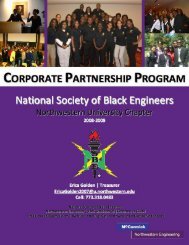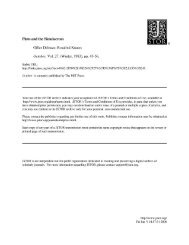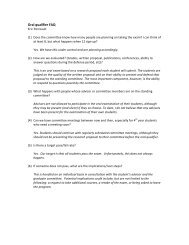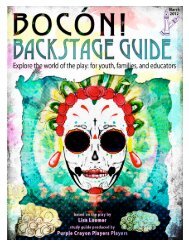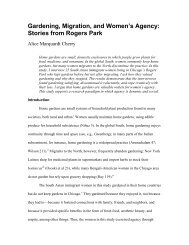research - Associated Student Government, Northwestern University
research - Associated Student Government, Northwestern University
research - Associated Student Government, Northwestern University
You also want an ePaper? Increase the reach of your titles
YUMPU automatically turns print PDFs into web optimized ePapers that Google loves.
RESEARCHmedical treatment. Many experiment with traditionalAfrican healing since healers claim to have a cure toHIV/AIDS. 17 Alternating between medical and Africanhealing causes additional difficulties because ARVs willnot produce the desired results, further impairing Africans’trust in the foreign man’s advice.The beliefs regarding the motives of the foreign doctor,the fate of an HIV victim, and the limitations ofmedicine all have a presence in African culture and needproper consideration. Even if sufficient funding existedto provide Africans with condoms, ARVs, and propermedical attention from physicians, HIV/AIDS transmissionsand deaths would likely persist. In order for Africato achieve significant progress, the social and culturalcomponents of the problem also need attention.Catholic ResponseI. StrengthsThe Catholic Church complements medicine bypromoting the social aspects of HIV/AIDS treatmentand offering a comprehensive model for healing. Technicalhealing addresses the physical component of thedisease, and African healing aims to cure the disease bytargeting the disharmony and disorder present in thecommunity. Christian healing shares similarities withboth:healing is ... the involvement with Jesus…witheverything that diminishes our humanity, the powersof evil, the various contemporary idols of death.Health is therefore more than a mere absence of illnessin whatever form, but implies wholeness, fullness oflife. 18The story of the Gospel acknowledges that a completeprocess of healing requires patience, friendship,and love. 19 Furthermore, Catholics believe that theBody of Christ connects the diseased with the healthy. 20Instead of occupying a distinct space from the healthy,this approach to healing directly promotes solidaritywith patients and helps to eliminate HIV/AIDS relatedstigmas. The Church approaches healing as a lifelongprocess that needs broad community-based supportrather than a single-factor based solution. This approachcomplements Africans’ perception of health inwhich one’s community is directly linked to healing. 21In addition to providing a holistic model of healing,the Church has a long history of protecting themarginalized. The disadvantaged have the least abilityto obtain the medical attention they need, but they havethe highest risk of disease contraction. In addition tohealthcare, Catholic FBOs cover a full range of servicesfrom education to micro financing. Their commitmentto social justice enables them to target the social andeconomic components of the disease by empoweringwomen and eliminating poverty. The Church looks forpeople in need and acts as their advocate without anyother agenda.The Catholic Church’s last major strength lies in itsVOLUME 7, 2011-2012extensive grass root ties. It established itself in Africalong before the HIV/AIDS crisis began and has alreadygained trust and community support: “Catholic massesin Africa…are not American priests in Africa; theseare African priests in African parishes. I was the onlywhite in the entire church.” 22 With the leadership ofthe Catholic Churches in the power of Africans, it isapparent that the Catholic Church has gained the trustand support of African communities. Trust will enableagencies to help change social norms and values regardingsexuality, gender, and disease management.II. ContraceptivesWhile the Catholic Church may effectively addressthe certain components, objections arise due to Catholics’opposition to contraceptives. Even if condom useis not a panacea, a complete denial of its importanceblocks progress. The Catholic Church believes that allpeople have the ability to abstain from sex until marriageand maintain fidelity within marriage, but we canconclude from simple observation that people do notunanimously adhere to Catholic teachings in practice.Additionally, condoms prevent the spread of HIV betweensero-discodant couples within a marriage, andmedical clinicians recommend the use of condoms duringsexual relations between two HIV positive people inorder to prevent re-infection. 23 Thus, even in a chasteand faithful marriage, condoms have a necessary place ifone or both partners are HIV positive.Observations and evaluations indicate that CatholicFBO volunteers focus on different issues when in thefield than those residing in developed countries. Problemssuch as disease, poverty, death, and hunger provefar more pressing than issues of sexual freedom. 24 ChrisCarroll, a <strong>Northwestern</strong> sociology graduate student,described that during his fieldwork in South Africa thenuns heavily focused on ways in which they could stopthe HIV/AIDS epidemic, and depending on the location,some nuns would keep condoms in their parishesto distribute. 25 New York Times journalist, NicholasKristof, has observed similar practices on the ground,one priest whom he met said “that if he were pope, hewould build a condom factory in the Vatican to savelives.” 26 Practicality, rationality, and sympathy outweighorthodox policy in the midst of the HIV/AIDSepidemic. Instead of focusing on issues of sexuality,Catholic FBOs focus on solving social and structuralinequalities. Many FBOs still teach traditional programsgeared towards abstinence. This type of programhelps to provide a long-term methodological approachfor addressing behavior change. In order to achieve a90 percent reduction in HIV/AIDS prevalence rates by2031, a global health forecasting report indicates thatthe average number of sexual partners needs to decreaseby 70 percent. 27NORTHWESTERN UNDERGRADUATE RESEARCH JOURNAL15



